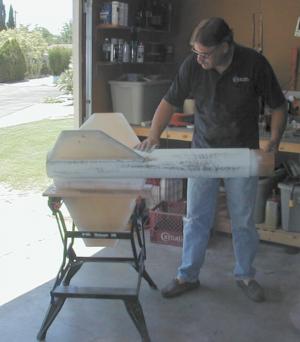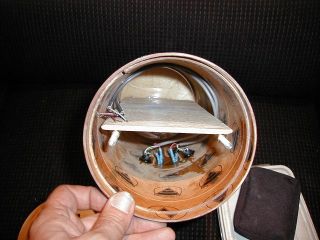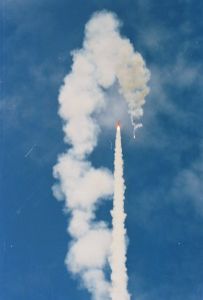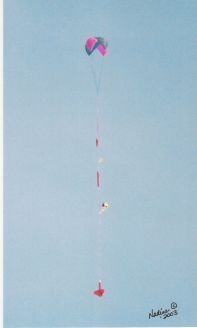Scratch Gravity Kills Original Design / Scratch Built
Scratch - Gravity Kills {Scratch}
Contributed by Donald Ball
| Manufacturer: | Scratch |
 Brief:
Brief:
Building a Level 3 rocket on a budget.
Construction:
The parts list:
- 1/4" Luan board
- 3/4" plywood
- 2 60"sections of Yazoo Mills 6" tubing
- 6" PML nosecone
- 2 48" sections of PML 6" coupler
- West Systems epoxy
- Krylon paint
My L3 project started with very little funds, so I needed to do this thing on a shoe string budget. With a little help from my friends, I discovered ways to do accomplish my goal of "cheap, but with quality". Starting with the fins, I had to try to figure out how to build really BIG fins cheaply. Thanks to suggestions, the fins were constructed using 1/4" Luan board, which has a very nice finish on one side, from Home Depot. I cut out six fins on the band saw and then epoxied them together in pairs with fiberglass matting sandwiched in between and the good side out on the wood. Having steel plates to hold the fins flat and tight while curing helped a lot too. I used 2 plates on the garage floor with 20 gallons of paint for weight on top. Considering the size of the fins, they are strong as the devil.


Next I used PML tubing for the 98mm motor tube and cut the centering ring with a band saw and a drill press, out of 3/4 cheap plywood. The question still remained, "Where can I find good strong airframe?" Friends solved my quest again, as Yazoo Mills 6" tubing worked perfectly with my 6" PML fiberglass nosecone and at a fraction of the cost of any other airframe on the market. These tubes have 1/4" thick walls and when soaked with a good epoxy, like West Systems, are strong enough for me to stand or jump on (and I'm 6'4" and 230lb--not bad!). This design will never hit Mach, not even with a N4800! It's a drag monster...
 Then I slotted the airframe with a standard saber saw so the fin and motor section would slide in nicely. The tubes cut very nicely, which I was pleasantly surprised by how these tubes are easy to work with. The rest was cake, just gluing the motor mount in and lots of fillets.
Then I slotted the airframe with a standard saber saw so the fin and motor section would slide in nicely. The tubes cut very nicely, which I was pleasantly surprised by how these tubes are easy to work with. The rest was cake, just gluing the motor mount in and lots of fillets.
Once the lower assembly was cured, I hurried up to cover the exposed wood with a sealer (as desert dryness warps unprotect wood fast). Adding a coupler for a zipper-less design was a small challenge, but it had to be strong because the aft end was going to weigh about 18lb at apogee. So 2 PML couplers inside of each other, a 3/4" plywood bulkhead screwed and epoxied in place, and then the inside side walls were matted with fiberglass and filled with 2 part foam.  I also used a 2" U bolt from Home Depot for the shock cord mount.
I also used a 2" U bolt from Home Depot for the shock cord mount.
Now comes the upper section. The heart of it is the payload bay. It uses 2 altimeters for redundant recovery. The altimeters used were a pair of PerfectFlite's miniAlt/WD. I enclosed them using a dual coupler and 2" airframe piece on the outside. 1/4" all-thread rod was used to hold it all together, including the mounting board for the electronics. The best switch for arming the altimeters I found was a 120/220V select switch from MissleWorks because they are flat and easy to mount. For the lower (drogue area), a 18" section is used and a 36" section for the upper (main chute area), all capped off with a 6" PML fiberglass nose cone filled with 2 part foam and a few more 2" U-bolts. 1 Sky Angle Cert 3 drogue and a Rocketman R14 for recovery are all held together with Rocket Rage "Cobra 3D" Shock cord. The last thing I added was a 1/4" X 6" thrust plate and a 98mm to 76mm adapter/motor retainer.
I figure the total cost to build this puppy was around $180.00 (not including chutes and electronics).
Finishing:
Again, "cheap" is the word of the day. 7 cans of white Krylon primer, 10 cans of Fire Engine Red, and 1 can of Gloss Black. Did I mention a lot of sanding? (My arm didn't work for a week after all the sanding.)



Flight:
SUCCESSFUL LEVEL 3 FLIGHT!
November 29, 2003
TurkeyShoot in Las Vegas
Rocket - Gravity Kills
Weight - 30 lbs
Motor - Aerotech M1315
Altitude ~6,700 feet
My L3 flight was in a drag race at TurkeyShoot in Las Vegas with Scott Ulrey and I both using M1315 motors. I borrowed the Dr. Rocket 76/6400 motor case too, thanks to Steve Hedland! Ready on the pad, time for a picture or two by Nadine, and then clear the area. The LCO called out "3...2...1...Launch!" My rocket wasn't the first one off the pad, as it took 3 to 4 seconds for pressure to build up. I don't know what kind of igniter Scott used, but it was the fastest I've ever seen an M motor fire up--it couldn't have been more than 1 second! Most people watched his rocket going up while mine sat on the pad, but Gravity Kills came to life, catching most of the spectators off guard, and roared off the pad in a perfectly straight flight, soaring to about 6700 feet. Seeing your rocket coming back under full chute on a L3 flight and recovering it with no damage is priceless!
I was certified Level 3 with all of my paper work signed and then given an L3 pin by the Club Perfect, Gordon McDaniel, right off his own hat.
I would like to thank John Sbare, Kendall Reed, Vince Serkus, Steve Hedland, Jerry McKinlay, Scott Ulrey (of Just Rockets), Lee Ellibee, Dave Pacheco, and of course, Mr. McDaniel for their help and knowledge base in my quest. This Tripoli Vegas group is about the best group of people I've ever met. Thanks to all of you for making a dream come true!
Summary:
PRO: The big fins make this flight straight as an arrow and very easy to see at 7000 feet.
CON: The big fins make this rocket hard to transport!
 |
 |